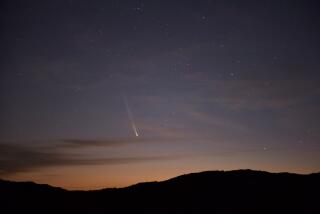Comets may be ‘aliens’ from way outer space, study finds
- Share via
Some of the most famous comets — like Halley and Hale-Bopp — may have originated in other solar systems, an international team of astronomers says — much farther away than they previously imagined.
Many comets originate in what is known as the Oort cloud, a vast rough sphere of comets that encompasses our solar system and extends nearly halfway to the next nearest star, Proxima Centauri. Scientists have thought that this cloud was formed during the birth of the solar system, about 4 billion years ago. As the planets formed, icy, rocky material was thrust farther and farther outward in space, eventually creating the Oort cloud.
But a team led by Hal Levison, a planetary scientist at the Southwest Research Institute in Boulder, Colo., says the theory may be wrong. In a paper published online Thursday in the journal Science, the researchers argue that the Oort cloud’s 400 billion objects could not have all originated from within the solar system: There are about 70 times fewer objects there than needed to explain the Oort cloud’s size.
Therefore, the team argued, a large portion of the material that makes up the Oort cloud had to come from somewhere else.
The astronomers suggest a different chain of events. The sun, they note, may have formed in a cluster of stars. That cluster could have been surrounded by a body of comets that had been pulled out of their orbits around the individual stars. Before the star cluster fully dispersed, the sun was able to capture a large cloud of these comets.
If the theory is true, it could mean that samples of the chemistry of several solar systems exist relatively close to home and can provide information about distant stars’ evolution and composition, Levison said.
Julio Fernandez, an astronomer with the University of the Republic in Uruguay, said the study was interesting but relied on several assumptions. Among them: that the sun formed in a star cluster; that every star in such a cluster formed a planetary system with a comet swarm around it, just like ours; and that the sun was close enough to other stars in the cluster to be able to capture an entire comet cloud.
Hans Rickman, an astronomer with Uppsala University in Sweden, agreed that the theory needed further study. For one thing, he said, “it may turn out that the real number in the Oort cloud is quite a bit lower than we think.”
Fernandez and Rickman were not involved in the study.
If the theory turns out to be true, the information that could be gleaned from these “alien” comets could tell researchers plenty about the early protoplanetary disc that evolved into our solar system — as well as what other solar systems looked like in their early formation, Levison said.
“It’s like a crime scene investigation of a brutal murder — sometimes blood spatter on the wall tells you more about the crime than the bodies themselves,” he said.





